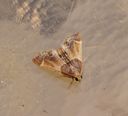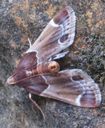Pyralis
Pyralis
Classification
- Phylum: Arthropoda
- Subphylum: Hexapoda
- Class: Insecta
- Order: Lepidoptera
- Superfamily: Pyraloidea
- Family: Pyralidae
- Subfamily: Pyralinae
- Tribe: Pyralini
- Genus: Pyralis
Pronunciation
How to pronounce Pyralis: /pɪˈræɪlɪs/
These audio files are automatically generated. While they are not always 100% accurate, they are a good starting point.
Images






Summary
Pyralis is a genus of snout moths first described by Carl Linnaeus in 1758, known for their association with stored grains through their larval feeding habits. They are cosmopolitan in distribution and have both economic significance and ecological roles.
Physical Characteristics
Pyralis species are characterized by their snout-like mouthparts, which give them their common name, snout moths. The forewings are often elongate and may exhibit a variety of colors and patterns depending on the species.
Identification Tips
Look for the distinctive elongated snouts of these moths, as well as their unique wing patterns that can help in distinguishing between species.
Habitat
Pyralis species are commonly found in environments where stored grains or other organic materials are present, especially in warehouses and homes.
Distribution
Cosmopolitan; present in many regions around the world, including North America, where two species are specifically noted.
Diet
Larvae are known to feed on stored grain products, making them pests in agricultural and storage settings.
Life Cycle
The life cycle of Pyralis includes the egg, larva (caterpillar), pupa, and adult moth stages, with larvae developing primarily in grain products.
Reproduction
Moths reproduce by laying eggs, which hatch into larvae that feed on appropriate substrates. The specifics of mating behaviors or processes are not detailed in the provided data.
Predators
Natural predators may include birds, bats, and other insectivorous animals, as well as parasitoids that target their larvae.
Ecosystem Role
As grain feeders, the larvae of Pyralis play a role in the decomposition of organic materials but can also impact human food supplies.
Economic Impact
Pyralis species, notably the Meal Moth, are considered pests due to their feeding on stored grains, leading to economic losses in agricultural contexts.
Cultural Significance
The name Pyralis originates from historical texts referring to winged insects, reflecting cultural perceptions of moths.
Collecting Methods
- Light trapping
- Using bait traps with food sources like grains
Preservation Methods
- Pinned specimens in insect boxes
- Dried specimens stored in airtight containers
Evolution
Pyralis is part of a diverse lineage within the Pyralidae family, with its classification dating back to Linnaeus in the 18th century.
Similar Taxa
- Moths in the family Pyralidae
- Other snout moth genera like Aletes and Ceropsina
Misconceptions
The association of Pyralis with fire due to its name may lead to misconceptions about its habitat and behavior; they are primarily grain pests.
Tags
- Lepidoptera
- Pyralidae
- Pyralis
- Snout Moths
- Stored Grain Pests